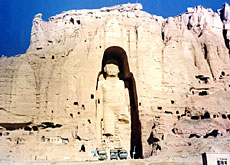Buddha’s reincarnation faces delay

Swiss scientists say they are ready to rebuild one of the giant Buddha statues destroyed in 2001 by Afghanistan’s former Taliban regime.
However the United Nations heritage organisation, Unesco, says it is far too early to make a decision on the project.
Researchers from the Federal Institute of Technology in Zurich have prepared a blueprint for reconstructing the Buddhas of Bamiyan, which were the oldest and tallest standing statues in the world.
On Wednesday, team leader Armin Grün announced that the reconstruction was technically possible.
“The only thing that’s lacking is a political decision,” he told a press conference in Geneva.
Grün estimates that it would cost $30 million (SFr40 million) to reconstruct the tallest statue – 53 metres high – to the state it was in before the Taliban had it destroyed.
At the moment, a mountain of rubble stands on the site. The statue was smashed into 4,000 pieces.
Grün said it was not possible to reassemble the original pieces but reconstruction was possible thanks to photographs from the 1970s.
He said the local population was very interested in the project and saw its potential as a tourist attraction generating income for the valley.
Memorial to violence
Grün added that international funds would be forthcoming if Unesco gave its support to the project.
However the heritage organisation says other tasks are more urgent.
“The priority is to stabilise the huge recesses in the cliffs where the statues once stood,” said Christian Manhart, Unesco’s Afghanistan specialist.
“Rebuilding the Buddhas could cost millions which would be better spent elsewhere.”
Other experts are divided over plans for the site partly because it is not known what the statues looked like when they were originally built, 1,800 years ago.
In the 17th and 18th century, the head and leg of the giant Buddha had already been damaged.
Meanwhile, the director general of Unesco, Koichira Matsuura, wants to leave the cliffs as they stand as a memorial to the violence of the Taliban regime.
Explosion
Grün reckons the money for the work should come from private donations and not public funds, which should be used for rebuilding the country’s shattered infrastructure.
The Japanese government has already give $800,000 (SFr1 million) to help stabilize the surrounding rocks which were also damaged when the statues were blown up.
The Taliban demolished the Buddhas in March 2001 saying they were an insult to Islam.
Scientists from Zurich visited the site this August to take measurements and gather information. They subsequently created a 3D computer image of the whole cliff.
In a separate development, the Swiss government is to give Unesco SFr397,000 ($294,000) to help finance the restoration of a fortress in the Bamiyan Valley.
Switzerland is also sending experts to train Afghan craftsmen in the restoration of traditional buildings.
In 2002 Switzerland contributed SFr194,000 to the restoration of the minaret of Jam in Afghanistan.
swissinfo with agencies
Buddhist monks carved the Bamiyan Buddhas more than 1,800 years ago.
The two great statues were 53 and 35 metres tall.
The former Taliban regime destroyed the Buddhas in March 2001.

In compliance with the JTI standards
More: SWI swissinfo.ch certified by the Journalism Trust Initiative

You can find an overview of ongoing debates with our journalists here . Please join us!
If you want to start a conversation about a topic raised in this article or want to report factual errors, email us at english@swissinfo.ch.